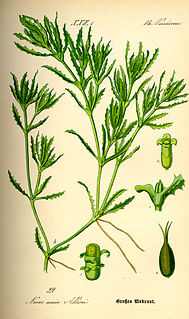
Cryptocoryne is a genus of aquatic plants from the family Araceae. The genus is naturally distributed in tropical regions of India, Southeast Asia and New Guinea.

Najas, the water-nymphs or naiads, is a genus of aquatic plants. It is cosmopolitan in distribution, first described for modern science by Linnaeus in 1753. Until 1997, it was rarely placed in the Hydrocharitaceae, and was often taken as constituting the family Najadaceae.

Nobuyuki Tanaka is an economic botanist at the Tokyo Metropolitan University, the Makino Botanical Garden in Kōchi Prefecture, Japan.

Cryptocoryne beckettii, also known as Beckett's water trumpet, is a plant species belonging to the Araceae genus Cryptocoryne.
Cryptocoryne affinis is a plant species belonging to the Araceae genus Cryptocoryne.
Cryptocoryne undulata, also known as undulate cryptocoryne, is a plant species belonging to the Araceae genus Cryptocoryne.
Cryptocoryne aponogetifolia is a species belonging to the Araceae genus Cryptocoryne.

Lemna trisulca L. is a species of aquatic plants in the arum family Araceae. It has a subcosmopolitan distribution. Unlike other duckweeds, it has submerged rather than floating fronds, except when flowering or fruiting.
Hendrik (Henk) Cornelis Dirk de Wit was a Dutch systematic botanist who contributed significantly to the knowledge of the Aroid genera Cryptocoryne and Lagenandra. He grew up in the Waterland, a marshy area in the Northwest Netherlands, and had a lifelong interest in aquatic plants.
Potamogeton maackianus is an aquatic plant species in the genus Potamogeton. It is found in slow moving fresh water.

Potamogeton octandrus is an aquatic plant species in the genus Potamogeton. It is found in slow moving fresh water.

Nechamandra is a monotypic genus of an aquatic plant family Hydrocharitaceae. The sole species is Nechamandra alternifolia. It is found in slow moving fresh water.

Aponogeton lakhonensis is a species of an aquatic genus Aponogeton, itself the only genus in the Aponogetonaceae family. This species with a yellow-flowered single spike rising above the water, is found in ricefields, ponds and slow-moving streams of tropical and sub-tropical Asia. An outlier population occurs in Sulawesi, the main area of occurrence is from Thailand to Zhōngguó/China and Assam in India. It is more closely related to tropical Australian species of Aponogeton than it is to other Southeast Asian species. In Thailand the whole plant is eaten is salads, whereas Cambodians prefer the leaves alone served with fish sauce.

Aponogeton natans is a species of aquatic plant in the family Aponogetonaceae.

Cryptocoryne spiralis is a plant species belonging to the Araceae genus Cryptocoryne.

Najas tenuis is a species of aquatic plant found in freshwater habitats, especially still or slow-moving waters, like ponds and rice fields.
Cryptocoryne usteriana is a species of aquatic herb in the family Araceae endemic to the Philippines. It was named after the German botanist Alfred Usteri who discovered the plant in the island-province of Guimaras in 1902. The species can also be found in the mainland Panay, in tributaries of lowland bedrock river with not too rapidly flowing water and seasonal flood pools. During the summer, its natural habitat dries up and plants undergo complete meltdown. The following monsoon rain and inundation triggers the remaining rootstock or rhizome to regrow quickly and send blooms underwater. Due to overcollection for the aquarium trade, the local government categorized it as threatened species.
Cryptocoryne parva is an aquatic freshwater plant, often grown in aquariums. It is the smallest know Cryptocoryne. Native to Sri Lanka, it grows as a small rosette reaching between 5 - 8 cm. Emerse leaves are a little wider than those growing under water. The spathe is c. 1.5 cm.










